Italy's largest international wine festival in Merano, a weekend in Vinschgau with the best Rieslings in the world and a comprehensive presentation of interesting autochthonous wines in Bolzano await wine lovers in South Tyrol every October and November.
Riesling Days Naturno (Vinschgau)
Stuart Pigott has already travelled the world when it comes to Riesling. "But", he said at the Riesling tasting in Naturno, which he commented on, "I have never experienced an event like the one staged this weekend in South Tyrol, where just 33.40 hectares (0.65% of the total vineyard area) are planted with Riesling. Not in the Rheingau, not in the Mosel and not in Alsace or the Wachau." More than 100 Rieslings, including the best in the world from the aforementioned growing regions (F.X. Pichler, Heymann-Löwenstein, Peter-Jakob Kühn, Zind Humbrecht and many more) as well as exotics from countries such as Luxembourg and even the Netherlands could be tasted. The whole thing is organised almost entirely on a voluntary basis by a few South Tyrolean wine maniacs.
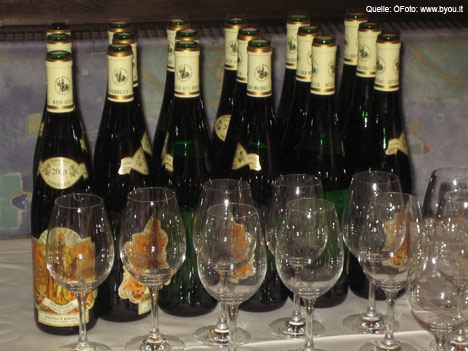 |
| A highlight of the Riesling Days: Vertical tasting of Emmerich Knoll's Rieslings |
In addition to the presentation of international top Rieslings, there is an extensive supporting programme, including the "Best Italian Riesling" competition. Here, a commission of 22 tasters (trade journalists, sommeliers, winemakers) will determine the best Riesling in Italy. Our chief taster Marcus Hofschuster was there. "I don't know of any jury tasting that takes place under more serious conditions!" he says afterwards, visibly impressed. Admittedly, the qualities at the top were not yet comparable to those of the established Riesling-growing regions, but the average qualities had shown themselves to be rather better than expected. The fact that three Rieslings from Vinschgau were among the top five in the tasting is hardly surprising for Hofschuster: "When I look at the vineyards, there is enormous potential here. I can hardly wait until the first Riesling comes onto the market that takes the excellent potential into account." In his opinion, it can't take much longer if producers stay on the ball.
The biggest event in the South Tyrolean wine autumn is the
Merano WineFestival
It was founded 15 years ago by three wine enthusiasts from South Tyrol, and in the meantime it has become the most important wine event in Italy alongside Vinitaly. However, the WineFestival is not a trade fair where any winery can participate if it pays the stand fee. The wineries eligible to participate and also the majority of the wines are selected by an expert commission of oenologists, restaurateurs, wine merchants, hoteliers, journalists, sommeliers, wine lovers and gourmets. This year, 540 producers were deemed worthy of participating in the festival. The largest contingent was of course the Italians with 306 wineries. Also represented in Merano were 44 members of the Grands Crus de Bordeaux, 13 Champagne houses, 33 businesses from Austria with a focus on Neusiedlersee, six Tokay producers and wine producers from Istria, Spain, Chile, New Zealand, Argentina, Portugal, Slovenia, Germany and South Africa. For sweet wine fans, 33 companies from Italy presented their products in the Dulcis in fundo section and friends of harder drinks could enjoy themselves at Aquavite & Cigars. For the past two years, the bio & dynamica event has been integrated into the WineFestival and to round things off, at the Culinaria you can taste artisan Italian delicacies from all parts of the country. With such an extensive programme, one must of course make a selection, which is admittedly difficult. Here are my impressions of the four days in Merano.
On the first day the choice was easy because the
bio & dynamica
took place one day before the main event. My impressions here were predominantly positive, both in terms of the selection of exhibiting companies and the quality of the wines presented. The ambience did the rest. South Tyrol in autumn, with its golden larch and chestnut trees and the changing colour of the vines, is a pleasure in itself. If you can also enjoy high-quality wines, most of which are produced according to strict organic guidelines, in the stylish ambience of a 750-year-old castle, there is not much missing for happiness.
As far as the quality of the wines on offer was concerned, I can't or don't want to single out any one in particular. At least none of the Italian ones, as all of them were actually good. What struck me most was the finesse and elegance that Sangiovese wines (Brunello, Chianti, Carmignano) can possess when they are vinified by terroir-loving winemakers. Of the non-Italians present, I was particularly impressed by Fleury's Champgner and Wimmer-Czerny's Grüner Veltliner from Wagram.
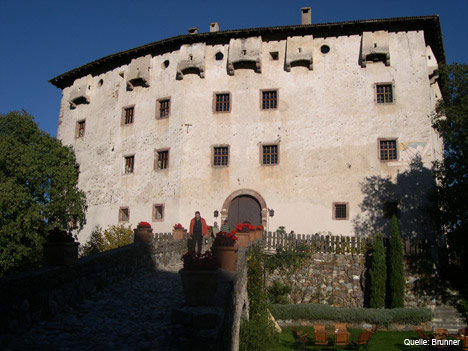 |
| Appropriate ambience for a successful wine presentation: The Castell Katzenzungen |
Apart from enjoyment, however, there were also discussions about wine, mainly of course about its organic production. Especially because at bio & dynamica, in addition to "organic hardliners" such as Wimmer-Czerny, Stefano Bellotti from Piedmont and Loacker from South Tyrol, there were also wineries represented that do not have organic certification, such as almost all members of the "Vini Veri" association. My opinion on this: The event is called "bio & dynamica" and the members of the "Vini Veri" association are always called "i biodinamici" in Italy and everyone assumes that these are 100% organic farms. If they now do not have a corresponding certificate, I am irritated and unsettled. I would like to see more clarity here and the security of an official seal would be helpful. To avoid misunderstandings: I think the work of the "Vini Veri" group is very good and important. Without these wines, Italy's wine world and also the bio & dynamica would be much poorer. White wines like those of La Castellada and Radikon from Friuli, the Barolo of Giuseppe Rinaldi and a Barbera collection like that of Trinchero from Asti, to name just a few, are jewels of Italian wine culture because they offer expressiveness and typicity at the highest level. Terroir without ifs and buts. And just like their colleagues with organic certification, they fully meet the demand that the initiator of this event and owner of Castell Katzenzungen, Caroline Pobitzer, places on the selected wines: "We want to present artisan, authentic wines that show a new way in the wine world". She succeeded in this and we can look forward to a new edition of the event next year.
For the second day, I had a visit to the main event at the Kurhaus in Merano on the agenda, but as soon as I arrived at lunchtime I was confronted with a still unsolved problem of the WineFestival, namely the crowds it attracts. The festival is slowly getting a problem with its success. Despite the not inconsiderable entrance fee of at least 60/day (which I think is absolutely fine for what is on offer), it was hopelessly overcrowded. I therefore didn't go in at all, but drove to the
Vini Culti
This event took place in Dorf Tirol, six kilometres outside Merano. Its motto was "Mr Lagrein receives Ms Nero d'Avola". Two typical, autochthonous Italian wines, one from Italy's northernmost region South Tyrol, the other from the southernmost growing region Sicily, were presented alongside other autochthonous growths from these growing regions in the historic ambience of the Castle Tyrol. This was accompanied by typical, predominantly organically produced culinary specialities from both regions.
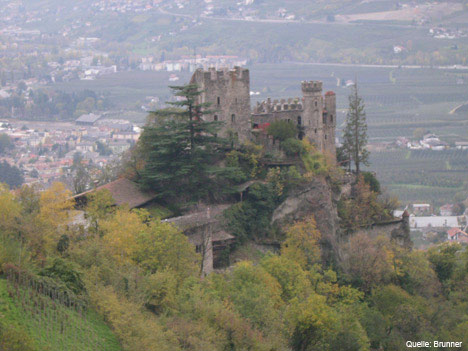 |
| View from Castle Tyrol Meeting place for wines from South Tyrol and Sicily |
In contrast to the main event in the Merano Kurhaus, most of the time there was a yawning emptiness here, so that the exhibiting producers rather made long faces and had to console themselves with getting to know the wines of their colleagues better. (A tip for the organisers: public transport in South Tyrol is very well organised. This should be better communicated in the event announcements. Or set up a shuttle from Merano to Tyrol Castle). The producers certainly enjoyed tasting each other's wines, as some of the best addresses from both regions were represented, some of them with remarkable wines. From South Tyrol, there were the top cooperatives from Tramin, Terlan and Bozen, renowned commercial wineries such as Brigl and Zemmer and also small, quality-oriented businesses such as Pfannenstielhof from Sankt Magdalena. Among the Sicilians, one could enjoy the wines of Planeta, Donnafugata and some interesting newcomers. But not only the wines presented, also the unique ambience would have deserved a larger number of visitors. I found the whole thing so interesting that I stayed until the end of the event and didn't even return to the overcrowded Kurhaus, but went to Kaltern, where the Manincor winery based there had invited us to a pleasant intermezzo. For the second time, the WineFestival held the
Vintner's Evening
took place. On this evening, the winery is open to invited interested parties. There was no programme here and that was precisely the beauty. In an informal atmosphere, one could enjoy a 5-course menu and the best wines in the architecturally impressive cellar with good music and self-service. The latter came from the house's own cellar and from fellow winegrowers present who were friends of the owners. The friends of the Goess-Enzenberg family were generous with their gifts, so that some of the best Barolo, Bordeaux, Riesling and Veltliner wines of the festival were available for tasting. So that the enjoyment could be completely carefree, the hosts had arranged a free shuttle service to and from Merano.
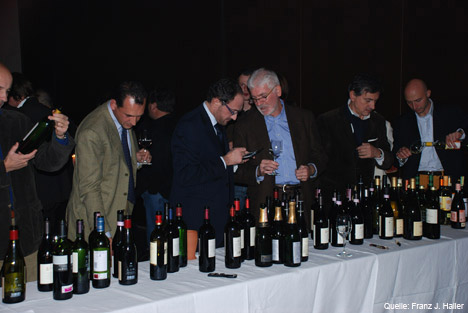 |
| The guests were spoilt for choice when it came to the wines they brought with them |
The main event at the Kurhaus
As already mentioned, the Winefestival is huge, so you have to make a choice. I opted for the "home team", i.e. the South Tyrolean exhibitors, as well as the section of
Vinis Extremis
This is rightly frequented by almost all visitors to the festival. The wineries presented here are characterised by the fact that they produce unusual wines. Like the Blanc de Morgeaux, which grows in the Aosta Valley at an altitude of 1,300 m, or the Cannonau di Sardegna of the Dettori winery, a wine with 17%, which does not taste alcoholic at all, but shines with elegance, depth and finesse. The same goes for the wines of Zýmè from Valpolicella. Unknown new breeds from the South Tyrolean experimental winery Lieselehof stand on the Vinis extremis next to rustic Italo classics like the Lambrusco by Graziano Vittorio from Emilia-Romagna. The most impressive wine in this section for me also comes from this region, the Cortiglio from the Ercolani winery made from the Uva Longaresi grape variety.
With its unconventional wines, this section of the festival is a must for all curious people with a penchant for genuine terroir wines.
South Tyrol at the Weinfesteival
The South Tyrolean home team, along with the Piedmontese and Tuscan exhibitors, regularly make up the largest Italian contingent at the festival, and everything of note is there: The cooperatives from Terlan, Tramin, Eppan, Girlan, Schreckbichl and Meran, the top-quality wineries such as Hofstätter, Lageder, Elana Walch, Arunda-Vivaldi, the Stiftskellerei Neustift, Tiefenbrunner and Lun, to name but a few. Only the so-called "free winegrowers" were rather weakly represented in terms of numbers, with only two representatives (Josefus Mayr and Manincor). Since this association of South Tyrolean direct marketers had booked a hall all to itself on the last day of the festival, this absence was, however, bearable, at least for festival visitors who were there for several days.
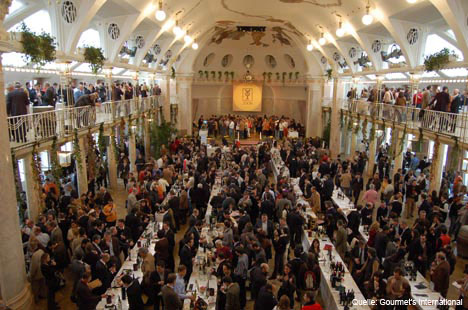 |
| The WineFestival is popular; it gets crowded sometimes |
The quality of the wines presented corresponded to the good reputation of the producers. For me, the Traminers from the Tramin Winery and Hofstätter as well as Sauvignon and Pinot Blanc from the Terlan Winery were outstanding. The impression of the red wines was somewhat mixed. Most of the Pinot Noirs were appealing and elegant; the Lagreins were powerful, even if sometimes somewhat strongly marked by wood. With the Cabernet, Merlot and the Cuveés from these two varieties, however, the desire to go a few halls further and taste the originals from Bordeaux became very strong. In general, after visiting the 27 South Tyrolean wineries, which had brought about 100 wines, the question arose for me: Where is the Vernatsch? In the official festival catalogue there is only Josefus Mayr's and apart from that only the Girlan and Egger-Ramer wineries had the courage to present this South Tyrolean classic at the festival. But there are many more high-quality wines from this classic South Tyrolean grape variety that not only do not need to hide behind most other reds, but often even surpass them. The elegant Sankt Magdalena wines from the hill of the same name in Bolzano, the long-lived growths from Girlan (the 90 Gschleier from the Girlan winery now even got the 3 glasses of the Gambero Rosso in retrospect) or the refreshing drops from Kaltern and the Merano hills. I had the impression that the South Tyroleans are almost somewhat ashamed of this wonderful, "simple" wine, at least at an event like the WineFestival. To enjoy this wine to the full, you had to wait until the last day. On this day, as mentioned, the
Free Winegrowers
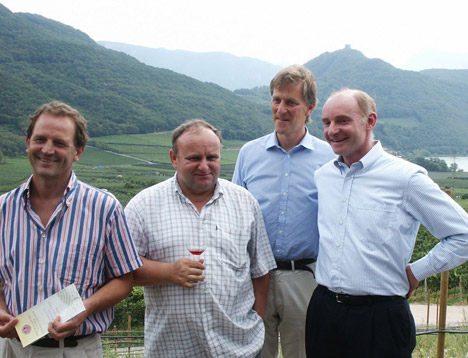 |
| could be satisfied with the performance of their "team": The board of the "Freie |
The board of the "Freie" had rented a hall at the festival and so I was able to enjoy the delicate, sometimes even somewhat mineral Saint Magdalener from Franz Gojer (Glögglhof), Thomas & Heinrich Rottensteiner (Obermoserhof) and Martin Spornberger (Kandlerhof). But South Tyrol is of course not only Vernatsch. South Tyrol is above all diversity in wine. There were hearty Sylvaner from the Eisack Valley from Garlider and Köfererhof; even fine Rieslings from Vinschgau from Gut Falkenstein, the winner of the tasting in Naturns, and from Castel Juval. Hearty Lagrein from Griesbauerhof and Pfannenstielhof. And also beautiful Pinot Noirs from Eppan (Stroblhof) and the South Tyrolean Unterland (Brunnenhof Mazzon and Ferrucio Carlotto). Even though there were some wineries among the "independents" that have only recently started bottling their own wines and whose wines had some minor technical deficiencies, this presentation with its diversity provided a more coherent picture of South Tyrol for me than the selection of wines in the main hall.
Connected to the WineFestival is the
Culinaria
Here, typical regional, artisan foods from all over Italy are presented. Many of them are organically produced and all of them - at least the ones I tried (you can't do them all here either) - are of a very high standard. A sensible and enjoyable addition to the WineFestival.
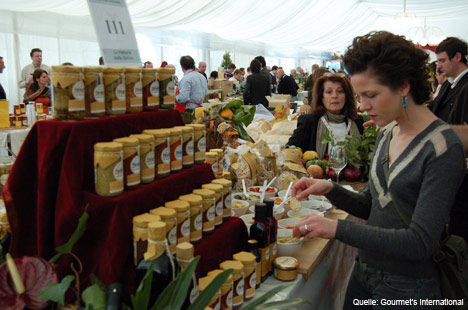 |
| Satisfactory all round: the Culinaria offer |
Short and simple conclusion: the Merano Winefestival is always worth a visit. In 2007 it will take place from 12 - 14 November.
A final tip: for all those who find four days too long, Merano too far or the entrance fee too high, the festival will probably tour the following cities in 2007 in a somewhat slimmed-down form, i.e. with fewer exhibitors:
Munich, Hamburg, Vienna (or Salzburg), Budapest, Zagreb, Prague, Paris, London and Valencia.
The dates will be published on the website www.meranowinefestival.com in the course of the year.
A few numbers smaller than the Merano Festival and with a different objective is the
Auchtona
This event has been taking place for two years now at the end of October at the Bolzano Exhibition Centre. As the name suggests, it is all about autochthonous wines, and exclusively those from Italy.
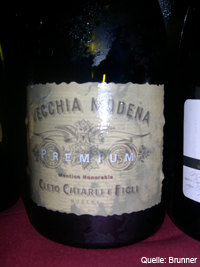 |
| An autochthonous classic from Italy: Lambrusco |
With a few exceptions (Terlan Winery and Elena Walch from South Tyrol), the big stars of the Italian wine scene are missing here. But that is the intention of founder Renato Tessaro, who runs a well-stocked enoteca at the Bolzano fairgrounds. "I could also introduce famous Brunello and Barolo wines. After all, these are also made from autochthonous Italian grape varieties. But everyone already knows them anyway. I'm interested in the unknown rarities or misunderstood specialities from Italy, like Schioppettino from Friuli, Erbaluce di caluso from Piedmont or the often-maligned Lambrusco from Emilia-Romagna. These are the wines that make up Italy's diversity and its appeal." And he has succeeded in creating a truly delightful compilation of Italian specialities. In addition to the wines mentioned, at Autochtona you can taste wines that many wine lovers have not heard of, such as Raboso and Oseleta from Veneto, Pelaverga and Erbaluce from Piedmont, NNerello Mascalese and Cappuccio from Sicily, Pecorino from the Marche or a white wine from the variety "La carica l'asino" (which the donkey carries), so named because it grows in the Piedmont-Liguria border region on such steep slopes that the grapes used to be transported away on donkey backs.
The majority of Chianti wines seemed somewhat out of place to me at the Autochtona. They were actually here unjustifiably, as almost all of the wines presented contained a not inconsiderable proportion of Cabernet Sauvignon and this was also clearly noticeable in the taste. And with some wines - not only, but especially from Tuscany - not much of the autochthonous grape varieties from which they are made could be felt due to the heavy use of barrique.
All in all, however, the Autochtona is a delightful event where one can make some interesting discoveries away from the usual mainstream.
The date for 2007 has not yet been set, but it is likely to be at the end of October again.